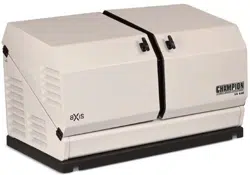Loading ...
Loading ...
Loading ...

aXis CONTROLLER HOME STANDBY GENERATOR
INSTALLATION
21
You may also lift the HSB using a properly rated strap, lift, hook
and hoist procedure attached to both steel lifting pipes, provided
that you use spreader bars to ensure that the belts, chains or
cables DO NOT touch/contact the HSB.
Once the HSB has been placed, check to make sure it is level. If it
isn’t, make adjustments prior to installation procedures start.
Installation Preparation
WARNING
Improper installation can result in personal injury and damage
to the generator. It may also result in the warranty being
suspended or voided. All the instructions must be followed
including location clearances and pipe size.
Once Site Selection, Preparation and Placement has been
completed, you can proceed to Installation Preparation. Without
these in place you may encounter problems moving forward.
There are a number of key items that MUST be addressed prior
to the physical installation of the HSB. The installation of the HSB
must comply strictly with all applicable codes, standards and
regulations (NFPA 37, NFPA 54, NFPA 58, and NFPA 70).
Check and confirm that the HSB on board controls are in the
“OFF” position. It is recommended to pull the control module fuse
located on the front panel and turn the circuit breaker to the OFF
position.
Champion HSB units have been run and tested at the factory prior
to being shipped. They do not require any type of break-in period.
CAUTION
The HSB is shipped without oil in the engine. Add oil to full
capacity as stated in the specification section before starting
the HSB.
Never operate the HSB with the engine oil level below the
“ADD” mark on the dipstick, doing so could damage the
engine. Check the oil level and add the appropriate viscosity
and amount indicated on the oil dipstick full line. The
recommended oil type for typical use is 5W-30 full synthetic
oil. Refer to Owner’s manual.
In the this segment, “Installation Preparation, the following will be
covered;
1. Fuel Requirements and Recommendations
2. Fuel Consumption
3. NG Pipe Sizing, flexible fuel line
4. LPG Vapor Pipe Sizing, flexible fuel line
5. Converting to LPG
6. Full Flow Shut Off Valve
7. Sediment Trap
8. Checking Pressure with a Manometer
9. Battery Requirements, Installation & Service
10. Wiring of the HSB
1. FUEL REQUIREMENTS AND RECOMMENDATIONS
The following NG and LPG fuel information is provided to assist
the fuel installer. This information should not be deemed to be
all inclusive or to conflict with local dry fuel codes. Consult your
local fuel supplier or Fire Marshall for guidance on proper local
codes and installations. Local codes will mandate correct routing
of gaseous fuel line piping around gardens, shrubs and other
landscaping to prevent any damage.
Special considerations should be given when installing the
HSB where local conditions include might flooding, tornadoes,
hurricanes, earthquakes and unstable ground. These are
considerations for the flexibility and strength of piping and their
connections.
NG is lighter than air and will collect in high areas. LPG is heavier
than air and will settle in low areas.
DANGER
Gaseous fuels such as NG and LPG are highly explosive.
Even the slightest spark can ignite such fuels and cause an
explosion, which could cause burns, fire or explosion resulting
in serious injury, property damage or even death. NO leakage
is permitted.
Recommended fuels should have a BTU content of at least 1,000
BTU’s per cubic foot for NG, or at least 2,500 BTU per cubic foot
for LPG. Ask the fuel supplier for the BTU content of the fuel.
Before NG fuel lines plans are made, call your NG supplier, provide
them information on the amount cubic feet/hour and the BTU’s/
hour that the HSB will use, and ask if the NG meter and primary
regulator can accommodate the addition of the NG generator. NG
companies have different meters for increased BTU demands.
Utilize the “Fuel Consumption (BTU) Chart” contained in this
manual or the Installation Manual for your specific HSB model.
Verify that the current gas meter is capable of providing enough
fuel flow to include household appliances and other loads
including the addition of the HSB. Check the NG primary regulator,
connected at the NG meter output. The correct primary regulator
is set at 5 to 7 inches water column. The existing primary
regulator may be undersized once the HSB is added.
The HSB engine can run on either NG or LPG. The HSB comes
equipped from the factory to run on NG. If your installation
requires the engine to run on LPG, orifices in the master mixer
assembly (carburetor) MUST be changed. The LPG orifices are
shipped with HSB. Refer to “Converting to LPG” in this manual or
the “Installation Manual” for your specific HSB model.
Loading ...
Loading ...
Loading ...
